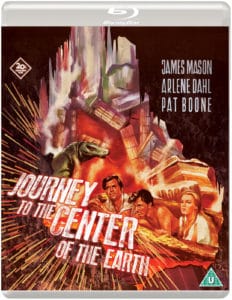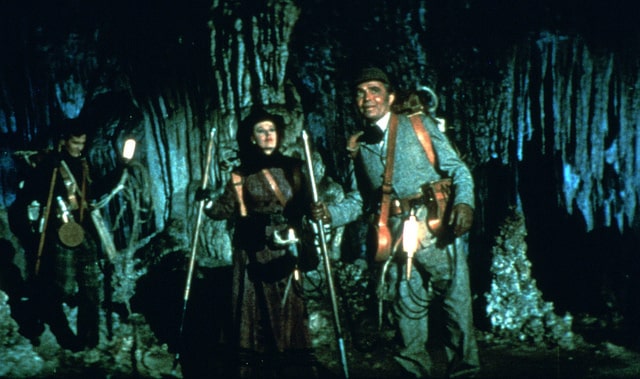We sometimes like to think that overblown, overpriced high-concept blockbusters with tacked-on love stories, two-dimensional bad guys and awkwardly inserted comic relief are an entirely modern phenomenon. Not so much, as this 1959 take on Jules Verne’s classic science fiction adventure stands to demonstrate. Decades before the Pirates of the Caribbean set sail, the Transformers, er, transformed, or indeed Brendan Fraser went on his own Verne-inspired hollow earth expedition, James Mason and Pat Boone portrayed a geology professor and his most overzealous student, whose chance discovery of a rock that should not be sets them off on a voyage of discovery which leads… well, the clue’s in the title. Of course, given Verne’s novel centres almost exclusively on three men and their journey, this lavish 20th Century Fox production from director Henry Levin adds a boatload of subplot and new characters including some love interest, a hissable villain, and… a duck. The results are, naturally, dated as all hell, but in many respects a good precursor for the demographic-fixated populist spectaculars that routinely fill up the multiplexes. (And I might note that I say all this as someone who routinely enjoys such films; hell, I seem to be among the few to have quite liked this year’s The Mummy.)
 So, it’s Journey to the Centre of the Earth, and as such we all know James Mason will be embarking on said journey, and that’s certainly enough to warrant audience interest. Unfortunately, we’re the better part of an hour in before the journey really gets underway, and in the meantime things are stretched out with a lot of inconsequential waffle that takes no time to get tedious. As the student Alec McEwan, Pat Boone – whose attempt at a Scottish accent makes Richard Attenborough in Jurassic Park look like Rab C Nesbitt – sings a few songs, as that’s what he was famous for at the time, and in that oh-so-chaste old Hollywood manner woos Miss Jenny (Diane Baker), niece of his esteemed teacher Professor Lindenbrook (Mason, who unsurprisingly makes for a more credible Scotsman, although I’m one of those who can never hear his voice without thinking of Eddie Izzard). After Alec’s chance gift to his teacher of an unusual-looking rock from an old curiosity shop turns out to be the most unique geological find of the century (admittedly, I don’t recall how they made the discovery in Verne’s novel, but was that really the best they could come up with?!), a race to be the first to the earth’s core begins, and so the film embellishes Verne further with rival scientists trying to capitalise on Lindenbrook’s discovery, resulting in a murder plot that eventually saddles Lindenbrook and Alec with a third party, Arlene Dahl’s widow Carla Göteborg. From that point she and Lindenbrook have a proto-Moonlighting antagonistic relationship which soon gives way to romantic tension – alarmingly quickly, really, considering the woman’s husband hasn’t even been buried yet.
So, it’s Journey to the Centre of the Earth, and as such we all know James Mason will be embarking on said journey, and that’s certainly enough to warrant audience interest. Unfortunately, we’re the better part of an hour in before the journey really gets underway, and in the meantime things are stretched out with a lot of inconsequential waffle that takes no time to get tedious. As the student Alec McEwan, Pat Boone – whose attempt at a Scottish accent makes Richard Attenborough in Jurassic Park look like Rab C Nesbitt – sings a few songs, as that’s what he was famous for at the time, and in that oh-so-chaste old Hollywood manner woos Miss Jenny (Diane Baker), niece of his esteemed teacher Professor Lindenbrook (Mason, who unsurprisingly makes for a more credible Scotsman, although I’m one of those who can never hear his voice without thinking of Eddie Izzard). After Alec’s chance gift to his teacher of an unusual-looking rock from an old curiosity shop turns out to be the most unique geological find of the century (admittedly, I don’t recall how they made the discovery in Verne’s novel, but was that really the best they could come up with?!), a race to be the first to the earth’s core begins, and so the film embellishes Verne further with rival scientists trying to capitalise on Lindenbrook’s discovery, resulting in a murder plot that eventually saddles Lindenbrook and Alec with a third party, Arlene Dahl’s widow Carla Göteborg. From that point she and Lindenbrook have a proto-Moonlighting antagonistic relationship which soon gives way to romantic tension – alarmingly quickly, really, considering the woman’s husband hasn’t even been buried yet.
Oh, and then there’s the duck. Really, I’m struggling to remember what the hell the duck was doing there, although the simple answer, as Kim Newman suggests in his appreciation in the extras, is that Disney’s earlier Verne adaptation 20,000 Leagues Under The Sea teamed up Kirk Douglas with a cute seal, so Fox, looking to replicate that success, wanted Mason’s team to have a cute animal sidekick too.
I realise I’m being a bit mean about Journey to the Centre of the Earth, but it’s not as if the film doesn’t have its strengths; it’s just that, to my mind, they’re by far outweighed by the weaknesses. Still, we do have some nice underground adventure sequences, including a scene with a rolling boulder which we can safely assume inspired Lucas and Spielberg on Raiders of the Lost Ark; and, as is most fondly remembered, we have iguanas with fins strapped on their backs standing in for dinosaurs. There’s no denying such moments have a goofy charm, even if they’re nowhere near as cool as Ray Harryhausen’s stop-motion creations which elevated similar films to a higher level, and might have been advantageous here; as Newman also notes, the film actually omits some of the monster action from Verne’s novel, so it’s hard not to feel a bit short-changed on that front.
As you’ve no doubt surmised by now, Journey to the Centre of the Earth is a big thumbs down for me, and it gives me no pleasure to say this given how much I usually enjoy old-fashioned adventure yarns. It has moments, but at 2 hours 10 minutes it’s just too long and too padded out with gratuitous fluff for my liking. Still, if you’re not such a sourpuss and do have a liking for this movie, you’ll definitely want Eureka’s Blu-ray in your collection, as it looks and sounds terrific.
Journey to the Centre of the Earth is out on dual format DVD and Blu-ray on 18th September, from Eureka.
